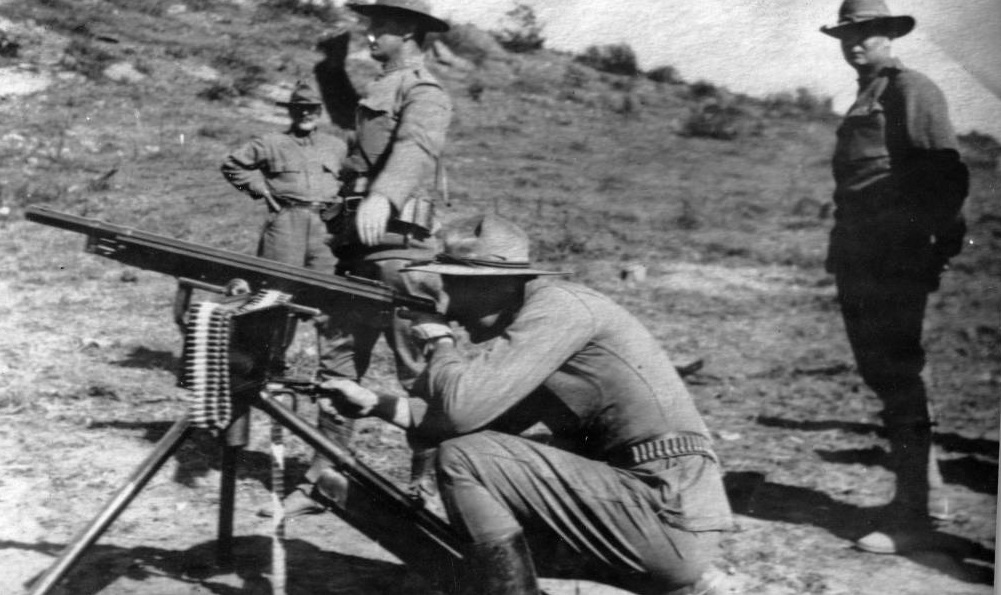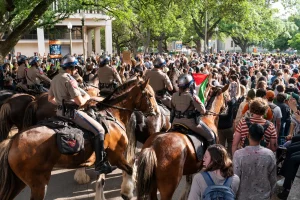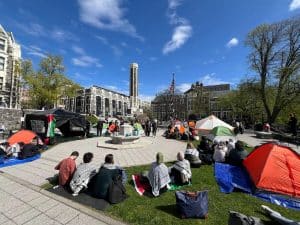The Second Amendment to the U.S. Constitution refers to a “well-regulated militia, being necessary to the security of a free State.” Most constitutional scholars consider it a reference to the Minutemen of the American Revolution, who were called to duty from their civilian occupations. Today, its equivalent is the National Guard.
“Regulated” by whom, and on whose behalf? The “security” of whose “State”? The general history of the National Guard makes these questions easy to answer — and on this day, the anniversary of the 1914 Ludlow Massacre in Colorado — it’s even easier.
On April 20, 1914, the Colorado National Guard joined private guards to attack a “tent city” that had been set up by striking coal miners in Ludlow, nestled at the entrance to a canyon in the foothills of the Sangre de Cristo Mountains 180 miles south of Denver. Today, Ludlow is a ghost town.
The United Mine Workers of America (UMWA) members had organized a general strike against multiple companies over the horrendous labor conditions in the coal mines throughout the southern part of Colorado. The strikes, which became known as the Colorado Coalfield War, began on September 23, 1913. That day, the famous labor organizer Mother Jones spoke at a rally outside the town hall in Trinidad, near Ludlow exhorting the workers to walk out. “Rise up and strike!” she declared. “If you are too cowardly, there are enough women in this country to come in here and beat the hell out of you.”
She added, “When we strike, we strike to win!”
There was sporadic violence during the strike, and action ebbed and flowed, but during the period a mine disaster in nearby Dawson, New Mexico collapsed on October 22, 2013, killing 263 miners. It spurred new militancy among the miners just north of the border with Colorado. Miners and their families began to erect “tent cities” — strike colonies near the mines to help protect themselves from sheriffs’ deputies and hired thugs brought in from other states, primarily by the Colorado Fuel and Iron Company (CF&I), partly owned by John D. Rockefeller, Jr.
Ludlow’s tent city was the largest — some 200 tents housing 1,200 people. The National Guard was sent in by the governor to “police” these strike colonies. The infamous Baldwin-Felts detective agency provided many of the hired guns augmenting the National Guard, and brought to Ludlow an armored car, nicknamed the “Death Special,” that was equipped with a machine gun and had been built at a CF&I shop in Pueblo. Other machine guns arrived, too — in the hands of the “militia,” the National Guard.
On the morning of April 20, the National Guard entered the tent city to demand that strikers release a man the Guard claimed was being held against his will. As the camp leader left to discuss this with the Guard major, the militia took positions on a ridge around the camp and soon thereafter opened fire with the machine guns. The battle lasted all day, with mine guards joining the fight and eventually with the Guard setting fire to the camp. In the end, the official death toll was 21 miners killed, but historians have established that 55 women and children were also murdered by the National Guard and its accomplices. In his People’s History of the United States, Howard Zinn describes four women and 11 children who suffocated as they hid underneath a tent. The Guard had gone from tent to tent, pouring oil on them setting them ablaze.
The Ludlow Massacre launched what came to be known as the Ten-Day War, with union members retaliating in guerrilla skirmishes against mine guards and mining facilities throughout southern Colorado. Upwards of 10,000 miners drove off or killed guards and scabs, and set fire to buildings. Eventually, President Woodrow Wilson sent in federal troops.
The strike ended on December 10, 1914, when the UMWA ran out of funds and called off the strike. None of the strikers’ demands were met, the union failed to win recognition, and replacement scabs took the jobs of many of those who had participated in the strike. More than 400 strikers were arrested and 332 of them were indicted for murder. The head of the National Guard units that attacked the Ludlow tent city was found guilty of murder, but the state Supreme Court eventually overturned the conviction. Some Guardsmen were court martialed. The Baldwin-Felts detectives were all acquitted, despite evidence of execution-style injuries on the bodies of their victims.
The legacy of the Ludlow Massacre for the labor movement is the subject of many works of historians. The legacy for the National Guard is less discussed, but it includes killing four students protesting the Vietnam War on the campus of Kent State University in Ohio in 1970. When you see the National Guard in the streets of Brooklyn Center, Minnesota — as it has been since the killing of Daunte Wright — or bivouacking in Minneapolis and other cities in anticipation of a verdict in the Derek Chauvin trial, remember the questions above. “Regulated” by whom, and on whose behalf? The “security” of whose “State”? The state that unleashes killer cops to terrorize communities of color is the same repressive state that sent in the National Guard to slaughter men, women, and children in Ludlow 107 years ago. And as for whose “security,” it is the security of the capitalist class these armed thugs protect — those in and out of uniform.
The Second Amendment to the U.S. Constitution refers to a “well-regulated militia, being necessary to the security of a free State.” Most constitutional scholars consider it a reference to the Minutemen of the American Revolution, who were called to duty from their civilian occupations. Today, its equivalent is the National Guard.
“Regulated” by whom, and on whose behalf? The “security” of whose “State”? The general history of the National Guard makes these questions easy to answer — and on this day, the anniversary of the 1914 Ludlow Massacre in Colorado — it’s even easier.
On April 20, 1914, the Colorado National Guard joined private guards to attack a “tent city” that had been set up by striking coal miners in Ludlow, nestled at the entrance to a canyon in the foothills of the Sangre de Cristo Mountains 180 miles south of Denver. Today, Ludlow is a ghost town.
The United Mine Workers of America (UMWA) members had organized a general strike against multiple companies over the horrendous labor conditions in the coal mines throughout the southern part of Colorado. The strikes, which became known as the Colorado Coalfield War, began on September 23, 1913. That day, the famous labor organizer Mother Jones spoke at a rally outside the town hall in Trinidad, near Ludlow exhorting the workers to walk out. “Rise up and strike!” she declared. “If you are too cowardly, there are enough women in this country to come in here and beat the hell out of you.”
She added, “When we strike, we strike to win!”
There was sporadic violence during the strike, and action ebbed and flowed, but during the period a mine disaster in nearby Dawson, New Mexico collapsed on October 22, 2013, killing 263 miners. It spurred new militancy among the miners just north of the border with Colorado. Miners and their families began to erect “tent cities” — strike colonies near the mines to help protect themselves from sheriffs’ deputies and hired thugs brought in from other states, primarily by the Colorado Fuel and Iron Company (CF&I), partly owned by John D. Rockefeller, Jr.
Ludlow’s tent city was the largest — some 200 tents housing 1,200 people. The National Guard was sent in by the governor to “police” these strike colonies. The infamous Baldwin-Felts detective agency provided many of the hired guns augmenting the National Guard, and brought to Ludlow an armored car, nicknamed the “Death Special,” that was equipped with a machine gun and had been built at a CF&I shop in Pueblo. Other machine guns arrived, too — in the hands of the “militia,” the National Guard.
On the morning of April 20, the National Guard entered the tent city to demand that strikers release a man the Guard claimed was being held against his will. As the camp leader left to discuss this with the Guard major, the militia took positions on a ridge around the camp and soon thereafter opened fire with the machine guns. The battle lasted all day, with mine guards joining the fight and eventually with the Guard setting fire to the camp. In the end, the official death toll was 21 miners killed, but historians have established that 55 women and children were also murdered by the National Guard and its accomplices. In his People’s History of the United States, Howard Zinn describes four women and 11 children who suffocated as they hid underneath a tent. The Guard had gone from tent to tent, pouring oil on them setting them ablaze.
The Ludlow Massacre launched what came to be known as the Ten-Day War, with union members retaliating in guerrilla skirmishes against mine guards and mining facilities throughout southern Colorado. Upwards of 10,000 miners drove off or killed guards and scabs, and set fire to buildings. Eventually, President Woodrow Wilson sent in federal troops.
The strike ended on December 10, 1914, when the UMWA ran out of funds and called off the strike. None of the strikers’ demands were met, the union failed to win recognition, and replacement scabs took the jobs of many of those who had participated in the strike. More than 400 strikers were arrested and 332 of them were indicted for murder. The head of the National Guard units that attacked the Ludlow tent city was found guilty of murder, but the state Supreme Court eventually overturned the conviction. Some Guardsmen were court martialed. The Baldwin-Felts detectives were all acquitted, despite evidence of execution-style injuries on the bodies of their victims.
The legacy of the Ludlow Massacre for the labor movement is the subject of many works of historians. The legacy for the National Guard is less discussed, but it includes killing four students protesting the Vietnam War on the campus of Kent State University in Ohio in 1970. When you see the National Guard in the streets of Brooklyn Center, Minnesota — as it has been since the killing of Daunte Wright — or bivouacking in Minneapolis and other cities in anticipation of a verdict in the Derek Chauvin trial, remember the questions above. “Regulated” by whom, and on whose behalf? The “security” of whose “State”? The state that unleashes killer cops to terrorize communities of color is the same repressive state that sent in the National Guard to slaughter men, women, and children in Ludlow 107 years ago. And as for whose “security,” it is the security of the capitalist class these armed thugs protect — those in and out of uniform.











